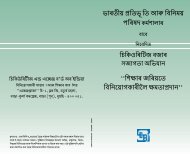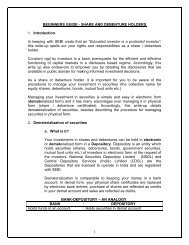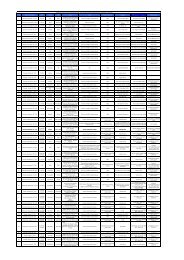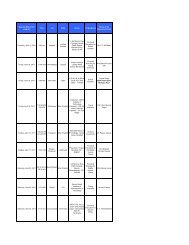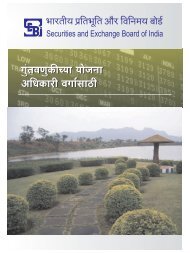financial planning 3. - Securities and Exchange Board of India
financial planning 3. - Securities and Exchange Board of India
financial planning 3. - Securities and Exchange Board of India
- No tags were found...
Create successful ePaper yourself
Turn your PDF publications into a flip-book with our unique Google optimized e-Paper software.
Here’s an example <strong>of</strong> some <strong>of</strong> the asset allocation models for different stages in your investing life.What they show is a gradual movement from aggressive to conservative style <strong>of</strong> investment.Asset MixYears to retirement Stocks Bonds Cash20 80% 10% 10%15 60% 30% 10%10 40% 50% 10%5 30% 60% 10%Remember that models such as these aren’t designed to predict a particular level <strong>of</strong> return.While allocating assets can help you moderate risk, it doesn’t eliminate the possibility <strong>of</strong>accumulating less than you’d like. Also, remember that an asset allocation isn’t fixed—as timepasses <strong>and</strong> you near retirement, you may want to consider shifting some <strong>of</strong> your stock holdingsinto more conservative choices to avoid the impact <strong>of</strong> short-term drops in the market.10. COMPOUNDINGTime exerts the greatest influence on your investment portfolio than any other force.Through the power <strong>of</strong> compounding, a small amount <strong>of</strong> money over time can grow into asubstantial sum. Compounding is an investor’s best friend. Investments can increase in valueover time, <strong>and</strong> the longer the time frame, the greater the value. This is achieved through returnsthat are earned, but not spent. When the return is reinvested, you earn a return on the return<strong>and</strong> a return on that return <strong>and</strong> so on. Therefore, it is important to start saving early in order tobenefit from the power <strong>of</strong> compounding returns.The time value <strong>of</strong> money is the value <strong>of</strong> money that has earned an interest over a given amount<strong>of</strong> time. For example: Rs 100 invested today for one year at 5% interest will be Rs105. Thus, tothe investor, Rs 100 paid now is no different than Rs 105 paid one year from now.The valuation <strong>of</strong> a likely stream <strong>of</strong> income in the future, in such a way that the annual incomesare discounted <strong>and</strong> then added together, thus providing a lump-sum “present value” <strong>of</strong> theentire income stream that is likely in the future. Thus PV is the present value <strong>of</strong> future money.For example, a sum <strong>of</strong> FV to be received in one year is discounted at a rate <strong>of</strong> interest to give asum <strong>of</strong> PV at present:PV = FV/ (1+r)Future cash flows are discounted at the discount rate, the higher the discount rate, the lowerthe present value <strong>of</strong> the future cash flows. The importance <strong>of</strong> time value <strong>of</strong> money in investment<strong>and</strong> conserving the value <strong>of</strong> your money is crucial. You need to invest in order to protect thevalue <strong>of</strong> your moneyActivity: List down the various items you <strong>of</strong>ten use <strong>and</strong> write down their value today <strong>and</strong>their value 10 years back. Compare the two values <strong>and</strong> observe how the value <strong>of</strong> money haschanged over time.15




